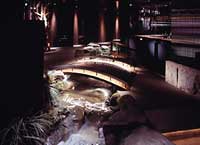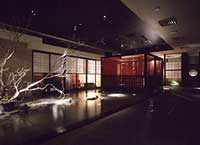|
|
|||||||
|
|
|||||||
|
|||||||
| | Web Japan >>| Trends in Japan >> | Lifestyle >> | The Sound of Silence | |
|
THE SOUND OF SILENCE "Hideaway Restaurants" Offer Peace in Busy Cities (October 17, 2003) Located in the middle of big cities yet shut off from the noise, some Japanese restaurants are becoming popular as oases of peace and quiet. These establishments, whose dim lighting tends to accentuate the soothing atmosphere, are frequented by such diverse clientele as middle-aged office workers, couples, and groups of young women. The customers come both for the atmosphere and the excellent food, which is mainly Japanese cuisine prepared using select ingredients.
Oases in the City Kawa No Hotori De (meaning "on the river bank") is one of these establishments, located in Tokyo's Minami-Aoyama district, which is home to a large number of fashionable boutiques and restaurants. There is a 25-meter artificial river flowing through the inside of the restaurant, along with soil, large stones, moss, and pebbles, all of which combine to bring an unexpected look to the interior of this restaurant in the middle of Tokyo. There are 25 private Japanese-style rooms facing the river, and the restaurant fare features seasonal vegetables. When US President George W. Bush visited Japan in February 2002, he and Prime Minister Koizumi Junichiro went to a restaurant in Nishi-Azabu called Gonpachi, a new establishment that offers oases of privacy within its spacious interior. Within the breezy atmosphere, cheery festival-like music plays faintly in the background, and the scenery features a farmhouse, a shrine, an alley, and other traditional Japanese scenes. Japan has a rich heritage of farming, so the atmosphere evokes a feeling of nostalgia among visitors. Hideaway restaurants are also very particular when it comes to the food they serve. Most serve Japanese cuisine with a creative twist, making copious use of seasonal ingredients in such dishes as sashimi and sushi. They also make a point of offering sake, shochu (a Japanese distilled liquor), and other drinks from different regions of Japan. Despite this insistence on quality and originality, diners can enjoy a meal at many hideaways for around ¥3,500 (about $29 at ¥120 to the dollar) a head.
Quiet Places to Enjoy Food and Conversation Amid the various stresses of modern city life, people are seeking places where they can get away from it all, and many enjoy the thrill of having a secret place that only they know about. "Hideaway bars" were once popular among working men who sought a place that was part neither of their workplace nor of their home, a place where they could relax and be themselves. Now hideaway restaurants have found broad appeal among men and women of all ages. Related Web SitesKawa No Hotori De (Japanese only) Gonpachi Copyright (c) 2004 Web Japan. Edited by Japan Echo Inc. based on domestic Japanese news sources. Articles presented here are offered for reference purposes and do not necessarily represent the policy or views of the Japanese Government. |
HERE'S TO SHOCHU (September 24, 2003) JAPANESE STYLE IS IN (April 24, 2002) IS JAPAN BECOMING A "CAFE SOCIETY"? (August 20, 2001) |
|
|




